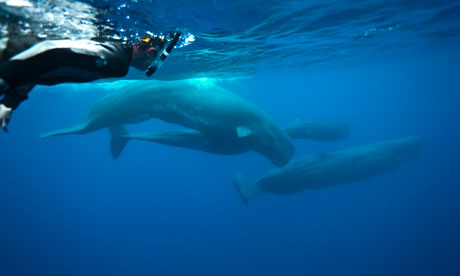Sperm whales: the 12-metre-long babysitters
Underwater mammals in the waters of Azores solve their childcare issues in a spirit of mutual cooperation
Azorean sperm whales have been found to look after one another's children. Photograph: Andrew Sutton
Sperm whales may be the biggest predators that ever lived, but they have childcare issues too. The solution? A very big babysitter.
Here in the Azores, where I've spent the past two weeks diving with sperm whales off the island of Pico, a resident population of these remarkable mammals search for their main source of food: squid.While the sperm whale is a natural submarine, able to dive a mile in depth for up to two hours, young calves still suckling their mother's milk (which is 60% fat, with the consistency of cottage cheese) cannot undertake such deep plunges. So while their mothers hunt for food, calves are cared for communally in what amounts to a cetacean creche. This accompanying image, taken by the accomplished underwater photographer Andrew Sutton, shows whale altruism in action. Only one of the four juveniles with this large female is hers; she may not even be genetically connected to the others.
João Quaresma of Espaco Talassa, our Azorean skipper, told me that to see four young with one female is unusual. "Calves start to feed themselves at around three or four years," he says, "but they've found whales up to the age of nine still suckling." Studies by scientists such as Dr Hal Whitehead of Nova Scotia University have shown that sperm whales organise themselves in highly complex societies, communicating in discrete dialects of sonar clicks, passing on culture learned matrilineally. Such behaviour reinforces what we are beginning to discover about the intelligence of these whales, which possess the largest brain of any animal.
Operating under special licence from the Azorean government which determines strict care for the whales' welfare, Andrew and I snorkelled with this group, watching them silently twisting and turning around one another in a physical expression of social solidarity. It was a salutary moment.
In the 20th century, our species came close to driving the great whales to extinction. This week, the International Whaling Commission meets in Jersey to decide the fate of cetaceans around the world. Conservationists hope that they'll make the right decisions.
Sometimes whales need more than a babysitter to help them – even when she's 12 metres long.


No comments:
Post a Comment